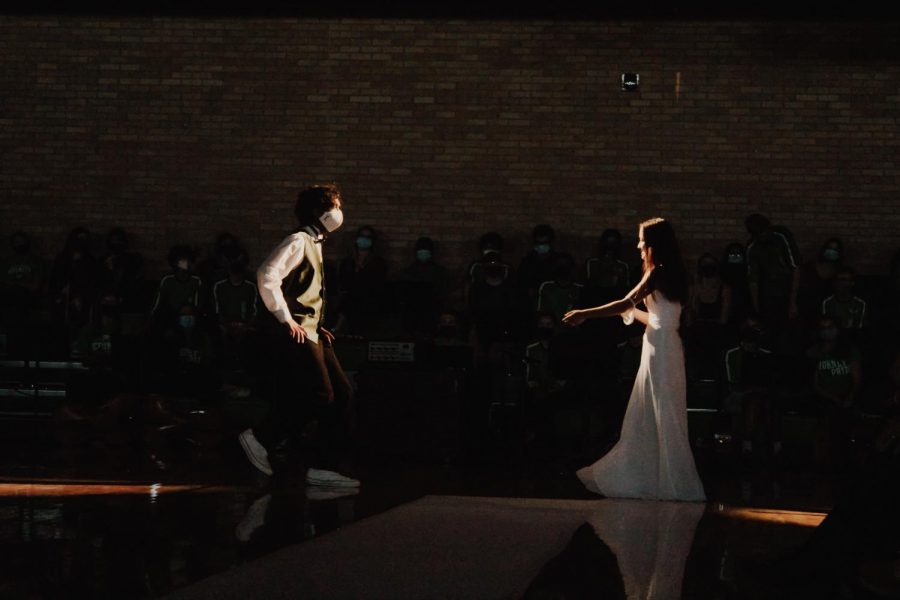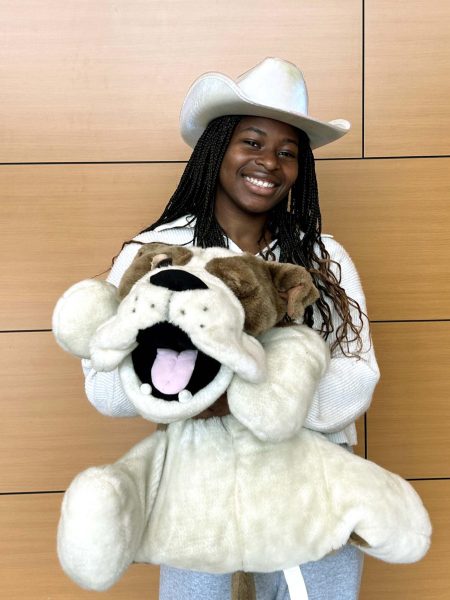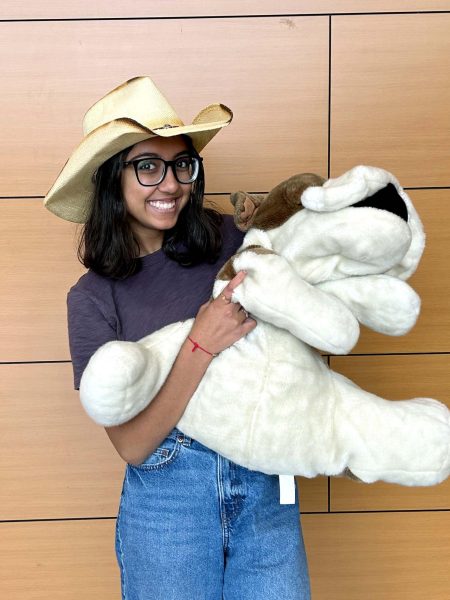“It takes a wave”: how Homecoming representation makes strides towards minority recognition in Edina
Myra Han and Atman Jahagirdar perform their homecoming dance prior to coronation
November 4, 2021
On Sept. 23, Atman Jahagirdar and Myra Han were crowned Homecoming King and Queen, bringing the spotlight onto underrepresented students at Edina High School and continuing the legacy of Shreya Konkimalla and Khoi Nguyen, Sweethearts Royalty who won Court earlier this year.
Edina High School is a predominately white school; its students are approximately 70% white, 12% Black, 10% Asian, 7% Hispanic, and 0.3% Native American. It can be difficult for students of color to feel comfortable on school grounds; a number of students have submitted their discriminative experiences at EHS to Edina Truth, an Instagram page devoted to giving a platform to students who feel unheard.
The experience for Asian students varies widely, usually ranging from feeling comfortable to facing frequent amounts of racism. Sophomore Reanne John feels accepted being the sole Asian student in certain settings. “I do extracurricular activities, so I feel like [with] a lot of my friends, I’m always often like ‘the Asian one.’ Most other people in my extracurriculars are white, so I’m usually the only one Asian, and I feel like they really do make an effort to make me feel welcomed,” John said.
However, seniors Jojo Orth and Colin McLaughlin, have had different experiences. “I think there’s stereotype[s] still, I think it’s really stupid, and there’s people [that] say it’s already handled, and it’s not much of a thing anymore but there’s obviously still stereotypes and people always, you know, say things like, I got called a [c-slur],” McLaughlin said.
“I get like the normal stereotypes of people assuming I’m really smart, which is fine I guess. In the past, I’ve got racist remarks, but nothing too bad. I’ve been told, like, open your eyes, stuff like that,” Orth said.
As the Queen, Han hopes to show Asian or underrepresented students at EHS that they’re not defined by societal stereotypes. “We’re not, you know, shy people and we have our own social relationships, and we’re able to connect with a lot of people,” Han said. “It’s not a coincidence that we’re here, and I hope that it just shows.”
Jahagirdar felt honored as the position traditionally encompassed white students. “It’s not just white students that are imagining getting these positions; it’s every person of color, probably one of the first thoughts is inherently a white person wearing the [crown] or a white person wearing the tiara,” Jahagirdar said. During his freshman and sophomore years, Jahagirdar fell foul to the same preconceptions. “I literally didn’t think it was possible for a person of color to be king or queen because I’d never imagined it. I’d never seen it.”
Jahagirdar said that he hopes that representation will break the stereotypes of the Asian populace and students gain a sense of freedom to push back against societal norms. “Whether they’re Indian or East Asian, I want it to be an idea where they [can] realize that they can be liked, and that they are as important to their community as any white person,” Jahagirdar said.
In 2021, four Asian students won royalty positions: Khoi Nguyen and Shreya Konkimalla as Sweethearts King and Queen and now, Jahagirdar and Han as Homecoming King and Queen. Konkimalla, currently an undergrad at Vanderbilt University, never imagined that her donning the tiara would impact EHS as a whole. Though winning portrayed her personal growth and escape from the isolation she felt, Konkimalla’s friends supported her and viewed her as an inspiration for women of color.
“Receiving messages like that was what made me realize that maybe it was a bigger deal than what I previously thought because it did just feel like, ‘Oh, it’s just a school dance, you know, this is just court,’ but I think it was a little bigger,” Konkimalla said.“Popularity or being someone who’s really seen in the school community comes with being white. Whiteness has always felt like it’s a requirement to be seen in Edina and important spaces in Edina.”
However, more people of color receiving representation is starting to change the rigid culture at EHS. “Seeing that is crazy, like seeing that change, and seeing more people of color get these positions and winning these types of things and court is really exciting,” Konkimalla said. “Because I think it just shows that maybe your community is having the right dialogues and conversations and is moving away from that narrative of whiteness.”
In future years, both Han and Jahagirdar hope that a wider array of students will be on Court or win royalty titles; anyone can wear the crown or tiara as long as they can relate to the Edina community. Jahagirdar wants people of color to understand their worth, especially in a largely white city. “[I hope to see] just, like, people of color being more encouraged to be themselves, knowing that to be Asian is something that they should be proud of and something that’s valued in the community.”
He ultimately hopes that students crowning Jahargirdar and Han as royalty will start to dismantle the Edinian customs where white students have been heard over students of color. “It takes a wave like this to create cultural changes.”




Anonymous • Nov 17, 2021 at 7:21 pm
As a person of color who graduated from Edina and grew up in whiter, more conservative places than Edina, this article is almost laughable. Anyone who claims that “I literally didn’t think it was possible for a person of color to be king or queen because I’d never imagined it. I’d never seen it” needs a major ego hit, especially considering that 3/4 total crowned royalty in the previous year were students of color (Homecoming king, and both Sweethearts queen and king as mentioned in the article). While it is true that there sometimes is a toxic culture of popularity at Edina that undoubtedly benefits white students, it simply is not true that “Popularity or being someone who’s really seen in the school community comes with being white.” Yes, stereotypes exist and personally affect many people of color Edina, but some of the individuals’ comments from this article make it seem as if they singlehandedly are solving the issues they describe. Jahagirdar’s savior mentality discredits the huge strides the Edina community as a whole has made with regards to racial stereotyping, and it attaches huge credit to a mere high school royalty contest instead of to the hundreds of students of color at Edina that work to change their peer’s impressions of them every day. Honestly, the victim complex from the individuals in this article honestly makes it harder to break racial stereotypes at the school.